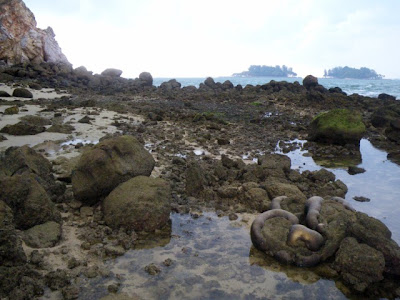Here's the highly delayed post of my diving adventures during end June at Lembeh Straits, Manado, North Sulawesi, Indonesia.
Lembeh is know for being the top muck-diving site in the world. And though the visibility is not so clear and the substrate looks plain and boring there's lots of life!
Thursday, July 30, 2009
Diving at Lembeh Straits Part 1
Tuesday, July 28, 2009
Back to Buloh for nem hunt
Finally, I get to join the Anemone army with Dr Daphne Fautin, world expert in sea anemones! Sadly, it's also the last trip of the series but it's better than never.
Two years ago, our finale hunt was Sungei Buloh and this time also. And Dr Daphne is looking for a special mangrove anemone that she chanced upon the previous trip. And here we go, working hard to find the nems.
Monday, July 27, 2009
Tanah Merah: life behind the seawall
Just before I spent most of the time checking out the corals beyond the seawall, I was exploring the sandflat that lies just behind the seawall. Despite being a reclaimed shore, there were still lots of animals to sight!
Sunday, July 26, 2009
Coral garden at Tanah Merah
I missed the previous Tanah Merah trip due to a serious bout of stomach flu. But this time, I am thankful for the good weather and the low tide.
With good weather and the super low spring tide, a small team of us managed to get to this part of the shore to explore the coral garden off Tanah Merah. At the background is the ferry terminal.
From my previous trip, I speculated that this is, so far, the best mainland coral reef in Singapore.
Saturday, July 25, 2009
Lively East Coast Shore
During my previous post, I shared about the rich sea fan gardens that can be found at the seawalls. As East Coast is a reclaimed shore, seawalls were constructed to prevent erosion of the reclaimed sand along the shore. Bays are thus formed between walls and over time, marine life have colonized the sandy shore.
The special find of the day on the sandy shore by Agnes must be this Spiny sea star (Gymnanthenea laevis).
Thursday, July 23, 2009
East Coast is packed with sea fans!
Finally I'm out at the shores again! This time back to East Coast Park. I explored several sites just last month. But since it's the longest reclaimed shore, there are still lots of stretches that are unexplored. I'm glad to have Agnes to join me for this 4am trip. Henrietta and friends, who are camping at East Coast, also joined for a while.
My focus today is to look at the sea fans at the outer edge of the breakwaters or seawalls.
And indeed, I was totally overwhelmed by the large number of
skinny sea fans found attached onto the seawall!
Saturday, July 18, 2009
Exploring a new part of St John's shore
After checking out the natural reefs of St John's Island with a special focus on anemones, we had to hide in the shelter for a while due to the bad weather. Good thing was that the rain became a drizzle and I spent the remaining time of the low tide period exploring a new part of St John's shore.
Monday, July 13, 2009
Natural reefs of St John's Island
St John's Island is one of the few southern islands with natural coastlines that the public can still access.
During a low spring tide, the pink outcrops and cliffs extends all the way to the sea as a rocky shore. And among the rocks are marine life that peeks out of water during the short few hours of low tide. These include the large boulder-like corals.
Sunday, July 12, 2009
Nems of St John's Island
For the past week of low tides, I wasn't able to explore the shores as I have already started full-time work. This has made me appreciate more of the Saturday low tides and I was glad to be able to go to St John's Island yesterday after a long absence from field trips.
In view of Dr Daphne Fautin's arrival later this month, anemones have become an important component of the lookout list for every field trip, including this one.
Monday, July 6, 2009
Beyond the murky waters of Changi
This is a super delayed part two posting of a field trip on 24th June at Changi. I fell ill for a long time and therefore updates have been bare minimum.
If you can recall, I last talked about the proliferation of gorgeous sea fans at Changi. During that day, it was one of the three days of the year where the tide went to the lowest possible, also as known as the lowest water level mark for the intertidal zone. Beyond which is the subtidal zone that will never get exposed theoretically unless there are changes in barometric pressure during the super low tide or that there is a ..... tsunami kind of natural event.
Changi waters are known to be rather murky. Justin had took a brave act before to dive off Changi and the visibility is just bad. But the bad visibility doesn't mean that Changi is lifeless. Changi as we know is home to lots of unimaginable diversity of marine life. And we took the lowest ever possible tide to catch a glimpse of what lies beyond the murky waters of Changi.
Here's what one can find at Changi at a rare low tide.
At the rocky side of the shore, there are many of the Melted chocolate ascidians on top of the colourful sea fans which I talked about earlier in another post.














.jpg)